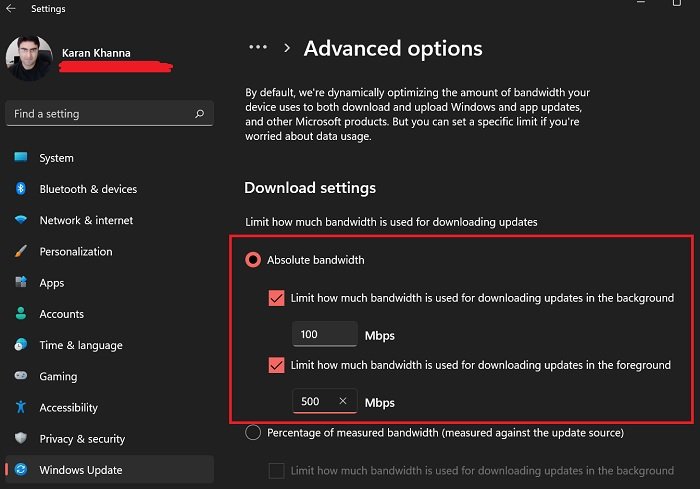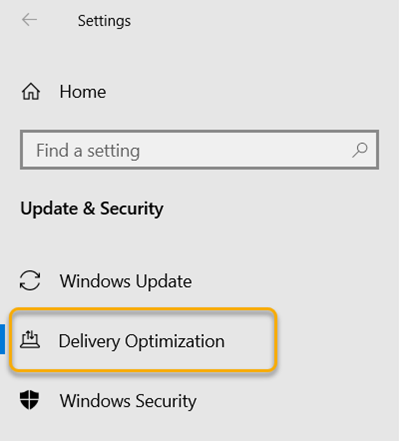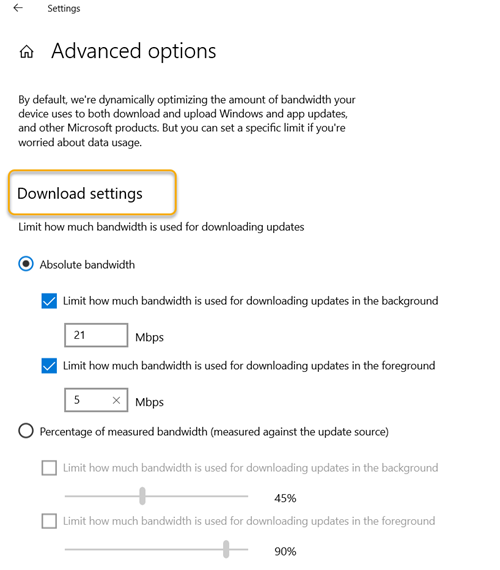Every Windows Update that is rolled out, includes programs and applications that contain packages with exceptionally large files. As such, downloading and distributing these updates can consume a sizeable amount of network resources on the devices receiving them. It is for this reason; Microsoft has introduced the Delivery Optimization feature to moderate bandwidth consumption. In this post, we will see how to specify the Absolute Bandwidth that can be used for downloading Windows Updates.
Delivery Optimization enables Windows 11/10 users to distribute the work of downloading packages with large files among multiple devices in a deployment. While you could limit the Windows Update bandwidth in percentage terms, you can mention the absolute values too.
Says Microsoft,
By default, we’re dynamically optimizing the amount of bandwidth your device uses to both download and upload Windows and app updates, and other Microsoft products. But you can set a specific limit if you’re worried about data usage.
Specify Absolute bandwidth that can be used to download Windows Updates in Windows 11

While there are options to mention the percentage of data that could be used to download Windows updates, a lot of users would prefer to specify an exact number of MBs to be permitted for the updates. The procedure to specify absolute bandwidth that can be used to download Windows Updates in Windows 11 is as follows:
- Right-click on the Start button and select Settings.
- In the Settings window, go to the Windows Update tab on the left pane.
- In the right pane, select Advanced options.
- Under Additional options, select Delivery Optimization.
- Now, scroll down and click on Advanced options once again for this new menu.
- Under download settings, check the radio button associated with Absolute bandwidth.
- Now you can check the checkboxes and decide the exact bandwidth to be sidelined for the downloads.
Limit Absolute bandwidth that can be used to download Windows Updates
To limit the Absolute bandwidth that can be used to download Windows Updates, do the following:
- Open Settings.
- Navigate to Update & Security.
- Choose Delivery Optimization.
- Click the Advanced Options link.
- Limit bandwidth for downloading updates.
- Limit bandwidth for Upload Settings.
- Limit bandwidth for uploading updates to other PCs on the Internet.
By default, Windows 10 has options configured to dynamically optimize the amount of bandwidth your device uses to both download and upload Windows and app updates and other Microsoft products. However, you can change and define the limit if you’re worried about your data usage.
Click the Start button, choose ‘Settings’, and select ‘Update & Security’ option.

Next, choose the ‘Delivery optimization’ option and switch to the right-panel.
There, click the ‘Advanced options’ link present at the bottom of the screen.

Now, check the ‘Absolute bandwidth’ circle to configure how much bandwidth is used for
- Downloading updates in the background.
- Downloading updates in the foreground.
The values are expressed in megabits per second (Mbps). You can also specify the same in terms of percentage value by checking the Percentage circle.
Once done, your settings will be saved instantly and applied. Simply close the Settings app and return to your work.
Thus with the new Absolute Bandwidth options, Windows 11/10 users can have more granular control over their data limits and its usage.
Why should you use this option instead of the percentage of bandwidth one?
In case you have a slower connection, you should use the option which specifies the exact bandwidth allocated to downloading Windows Updates. However, if your computer uses a fast internet connection, then you would want to keep the limit somewhat higher. This is under the knowledge that a few MBPS of data would be sufficient for rest of your work.
Does using less bandwidth slow down the Windows Update process?
It depends. Windows updates need a certain bandwidth to download the updates smoothly. Anything higher than that makes no difference. Anything slower would slow down the Windows update process.
Read next: How to manage the Data Usage Limit on Windows.
Leave a Reply